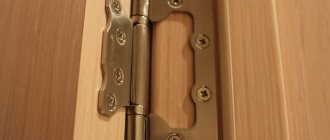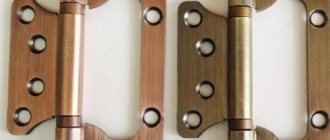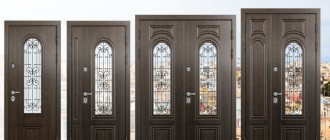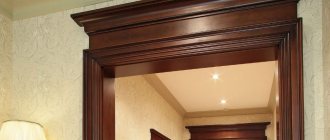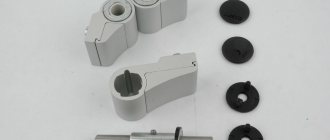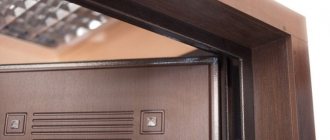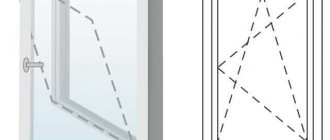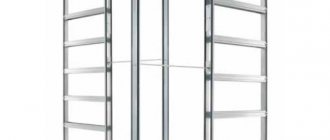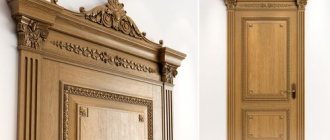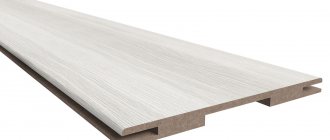The process of installing interior doors is a responsible job that is best entrusted to professional installers who actively offer their services in almost every region of our country. When inserting locks and hinges, a special power tool is required - a milling cutter and considerable experience in performing such installation processes. If this is not possible and the work has to be done with your own hands, the home craftsman is recommended to use overhead hinges without insertion.
Overhead hinges on an interior door in an apartment
Overhead hinge design
Hangers for door leaves that do not require insertion are distinguished by the presence of the following design features:
- They are made of alloy steel, stainless steel or brass with reduced deformation properties and increased corrosion resistance.
- Quality products are treated with galvanic coating, metal paint, powder pigments followed by heat treatment or other specialized compounds.
- Regardless of the absence of a recess, when closing, these hinges ensure a tight fit of the end of the door leaf to the frame with the formation of a standard joint. This is achieved due to a special slot on one of the plates, which exactly repeats the configuration of the response element.
Brass overhead hangers
When purchasing such hinges, it is recommended to pay increased attention to the quality and thickness of the metal, as well as the presence of paint and varnish coating, which significantly increases their durability.
Basic dimensions of butterfly loops
Overhead butterfly hinges are considered economy-class products, and each manufacturer focuses on the general public when supplying them to the market. In this regard, according to international standards, such products are divided into 2 basic categories:
- Hinge hangers designed for mounting doors weighing up to 30 kg - dimensions 100 x 75 x 2.5 mm.
- If the weight of the door panel exceeds the specified values and reaches 40–50 kg, then for such structures it is recommended to purchase reinforced hangers with dimensions of 125 x 75 x 2.5 mm. These products are characterized by the presence of a larger number of holes and an expanded contact area, which significantly increases their load-bearing capacity.
Butterfly hinges with dimensions 125 x 75 x 2.5 mm
It should be noted that many companies resort to some simple tricks. If the consumer sees that hinges of the same brand have different dimensions, but at the same time, the same number of holes are marked on them, there is no need to overpay for a large size.
Advantages and disadvantages of overhead loops
Overhead hinges are widely used for installing interior doors, due to the presence of many undeniable advantages:
- Low retail cost of products due to the small amount of metal.
- Easy to install - no special router required.
- Considering that such hinges are installed mainly in inexpensive doors with honeycomb filling or solid pine, the hangers can be fixed with a simple screwdriver.
Tightening the screws on the hinge
- These products are made in a universal version and are not divided into right or left.
- During normal operation of such hinges, the manufacturer guarantees their use for at least 7 - 10 years, without the need for replacement.
- There is also a special category of overhead hinges on sale, made with curved base plates. Such products are ideal for installing doors with rebates.
At the same time, such products have several important disadvantages:
- As a rule, they have a low load capacity. Recommended for use on door leaves weighing up to 30 kg.
Lightweight door leaf
- To dismantle the door leaf, you will have to unscrew all the screws on one of the plates, since the hangers are not equipped with a removable hinge rod.
- Given the weak material of lightweight panels, the screws can become loose over time, which causes the door to warp.
- Before installing such hangers, careful preparation of the door end will be required, since even the slightest unevenness can cause a loose fit, which will significantly complicate operation.
- To install the door leaf, you will need to hold it suspended or use spacer plates of the required thickness.
- Many consumers do not like the appearance of the overhead loop. In the open position, the large plate looks like a frame through which part of the blade material is visible, while the small part has insignificant dimensions and does not inspire confidence.
Overhead hangers in open state
Almost all the disadvantages are subjective and do not affect consumer demand.
How to adjust an interior door with butterfly hinges
Adjustment of card awnings may be required immediately after installing the door, as well as during its operation. The fact is that over time, fasteners weaken. This leads to problems with opening and closing the door. The sash begins to rub against the threshold, the top of the frame, does not close completely, etc.
Adjusting the hinges is necessary to set the correct position of the sash relative to the door frame. It can be carried out in three directions: horizontally, back and forth and vertically. In the first case, tighten or loosen the adjusting screw, aligning the door panel to the level. To adjust vertically, perform the appropriate actions with the upper and lower screws on the installation platform. To adjust back and forth, loosen the fixing screw on the hinge. Next, level the door by tightening or loosening it.
What tools are needed to install overhead hinges?
To install overhead hinges on interior doors, a home craftsman will need the following set of simple tools:
- A tape measure, a ruler with a steel blade, a carpenter's corner, a simple pencil - for marking the places where the hangers are installed.
- An awl or sharp nail for preliminary marking of holes for self-tapping screws exactly in the right place.
- A screwdriver with a set of bits for fixing hinges.
- Slotted or Phillips screwdriver for manually tightening screws.
Screwdriver with a set of bits
All tools must be of high quality, sharpened, cleaned of dirt and ready for use.
Step-by-step instructions for fixing overhead hinges
To install overhead hinges on an interior door with your own hands, a home craftsman will need to strictly follow all the steps of the following technological map:
- The canvas is fixed with clamps in a static position.
- As a rule, a smaller hinge plate is mounted on the door leaf itself.
Marking the door leaf
- The installation location is marked relative to the end edges of the door.
- The suspension plate is used as a template - the steel part is applied to the intended mark and carefully traced around the entire perimeter, as well as in the locations of the holes for the screws.
- The hinge plate is carefully removed to the side.
- In places where holes are marked for self-tapping screws, pilot holes are made with an awl or nail, strictly along their central axis.
- The hinge is again applied to the end of the door.
- The technician sequentially tightens all the screws with a screwdriver set to medium force.
- Upon completion of fixing the suspension, it is necessary to tighten each hardware until it stops using a hand screwdriver.
- The door with mounted hinges is brought to the frame and fixed with spacers to form the required gap.
- The master completely repeats the procedure for marking the holes for the counter plate on the vertical slope of the box.
- The hinges are fixed to the box material and tightened with a screwdriver.
Installation of butterfly hinges
Immediately after installing the door, it is recommended to check its opening and closing. If a misalignment is detected, it is recommended to immediately adjust the position of the canvas or hinges to avoid negative consequences.
Types of canopies
The main criterion for choosing hinges is the door opening side. The canopies themselves come in different types.
Mortise canopies
This is the most primitive and widespread variety. The design consists of two parts of the same size and shape. It is attached to the door with self-tapping screws. To ensure that the door can be closed without hindrance, the fastening plates are placed in specially prepared grooves.
Mortise awnings attract with their versatility, as they are suitable for most types of doors. Such hinges have only one opening side and can be changed simply by turning the canopy over.
Overhead canopies
The design of overhead canopies is similar to mortise ones. They also have only one opening side, they consist of two identical elements, they differ from the mortise type only in the installation method: here it is even simpler. The plates do not require special grooves; the hinges are simply attached to the end of the door and inside the frame.
Butterfly loops
This is the most practical option for an interior door. The name of the elements comes from their characteristic shape: when open, the canopies resemble nothing more than the wings of a soaring moth. Due to the shape of the hinges, when closed the canopy has the thickness of one element. When the canopy closes, one wing of the “moth” fits neatly into the other.
When installing such hinges, it is important to choose the right hardware. Their caps must be completely immersed in the grooves of the canopies, otherwise the door simply will not close. Butterfly hinges are not suitable for installing door leaves that are too heavy, since they are made of thin metal, have an openwork shape and, in addition to being a functional element, are also decorative.
Possible errors when installing overhead butterfly hinges and ways to eliminate them
When installing overhead butterfly hinges on their own, beginners may encounter a number of serious problems that lead to negative consequences, including complete replacement of the door leaf. To eliminate these errors, experts advise following a number of recommendations:
- Loose fit of the hinge plates with subsequent loosening of the mechanisms and distortion of the door. Before taking measurements, marking and fixing products, it is necessary to carefully check the tightness of the steel plate and, if necessary, level the installation plane.
- If the door cannot be aligned where the plate fits, it is recommended to use wooden wedges, matches or other available materials to eliminate the defect.
- It should be noted that many hidden hinges are sold with a ready-made set of spacer elements, with which you can ensure their tight fit to the end of the blade.
- The self-tapping screws rotate during fixation - this problem often arises if the hinge is mounted in an economy-class canvas with a thin wall and honeycomb filling. To eliminate such problems, it is recommended to immediately use a self-tapping screw with a maximum thread diameter and a sharp edge.
- When screwing a self-tapping screw, it is also important to control the tightening force, since there is always a risk of stripping the thread.
- After several months of intensive use, the canvas sags due to loosening of the screws. If such a problem occurs, it is recommended to immediately lift the blade and try to tighten all the hardware until it stops by hand. If this does not help, each self-tapping screw is replaced with a longer one with a different thread pitch.
Sagging door leaf
- If the door has sagged due to a broken thread in the structure of the door leaf material, it is recommended to prepare a special composition - PVA glue with sawdust, which is carefully filled with holes for the screws. After polymerization of the material, it is necessary to screw in the screws again, which guarantees their strength and reliable fixation of the loop.
High quality interior door with butterfly hinges
If you strictly follow the professional advice listed above, the installed overhead hinge will be used no less than the door leaf itself, without the need for major repairs or replacement.
Installation process
To understand how to install a butterfly hinge correctly, you need to take a closer look at its design. The technology for installing overhead models, as noted above, is determined by the specifics of their work. The absence of the need to form grooves is a significant advantage of such hinges; otherwise, the installation process follows the usual method.
First, the location of the loops is marked. It is advisable to apply them with the inside, and then fix the drilling points. The gap from the edges of the fabric should be at least 200 mm - the average distance not only for a butterfly loop, but also for conventional versions of this fitting. Then neat holes are made for the self-tapping screws, which are usually supplied complete with hinges. The final touch will be directly screwing the sides of the “butterfly” to the canvas.
